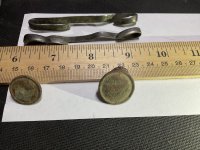Thank you guys, that is what I was looking for, video, pictures or info, NOT actual mercury.
Need the info for a documentary which I will attempt to embarrass Spain about polluting the ocean rather than trying to take all the treasure from those who have spent years locating it and recovering it.
Need the info for a documentary which I will attempt to embarrass Spain about polluting the ocean rather than trying to take all the treasure from those who have spent years locating it and recovering it.



